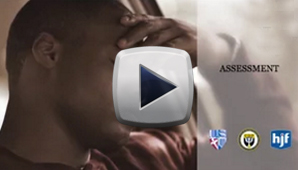
| Cognitive Behavioral Therapy for Insomnia Videos | ||
This video demonstrates the use of a role-play strategy as a cognitive intervention for unhelpful negative sleep-related beliefs. The therapist role plays a distressed coworker with sleep problems to elicit coaching from the patient on her understanding of CBT-I strategies, reinforces the patient’s progress in treatment, and recommends the patient use skills demonstrated in role-play for her own sleep beliefs....Watch now |
The therapist and patient meet again several months post-treatment to check current sleep quality and quantity, reinforce the patient’s use of relapse prevention strategies such as maintaining a consistent sleep schedule and getting out of the bed when awake if sleep problems recur, and discuss if/when to return to treatment....Watch now |
The therapist and patient review treatment progress by comparing goals at baseline with current report. The therapist uses psychoeducation to help set realistic expectations for further progress post-treatment. ...Watch now |
This monologue depicts an active duty psychologist sharing his experiences with and recommendations for treating sleep disturbances and insomnia while deployed with a specific unit.…Read More |
In this video, the therapist orients the patient to the sleep log, and then assists patient in filling in the previous night’s sleep information as an example. The therapist and patient work together to make a plan for how to complete the log. …Read More |
The therapist reviews sleep hygiene strategies with the patient via a handout, putting particular emphasis on those most relevant to the patient’s situation, in this case caffeine, and helping patient take steps toward implementing the relevant strategies. …Read More |
The therapist uses a motivational interviewing style to respond to the patient’s expressed ambivalence about engaging in sleep restriction and stimulus control, including reviewing the cons of not engaging in behavioral treatment. …Read More |
In this video, the therapist explores with the patient the underlying meaning of a negative sleep-related belief using the downward arrow technique and learns that this meaning may extend beyond surface sleep concerns. The therapist discusses how this belief may be impacted by poor sleep and vice versa, and discusses with the patient how to respond to the belief during the night.…Read More |
In this video, the therapist demonstrates a portion of a sleep-focused assessment with John; he assesses not just how long it takes to fall asleep and how much time is spent awake at night, but what the patient is thinking or doing at those times, weekend variations, substances that may affect sleep, and daytime functioning. Notice how the therapist keeps the patient on track despite occasional circumstantial responses.…Read More |
The therapist reviews the baseline sleep log with the patient, focusing on areas that are problematic for the patient’s sleep. Notice how the therapist does not confront the patient on unhelpful behaviors or make recommendations, instead simply identifying areas as a transition to stimulus control and sleep restriction in the next video.…Read More |
In this video, the therapist introduces the concepts of stimulus control and sleep restriction with a conversational approach. The therapist acknowledges some of the challenges of these interventions, allowing the patient to voice concerns and addressing them in a non-confrontational style, and identifies activities to engage in when awake out of bed.…Read More |
This video immediately follows the earlier video, in which patient expresses resistance to implement a consistent schedule across the week, particularly over the weekend. The therapist responds with motivational interviewing strategies, such as using a readiness ruler, encouraging the patient to voice his own change plans, and emphasizing personal control.…Read More |
The therapist reviews the patient’s efforts to engage in the recommended sleep schedule and identifies a challenge, the patient’s mental activation at bedtime related to current stressors. The therapist introduces worry time as a cognitive technique to address this mental activation.…Read More |
In this video, the therapist interactively uses the sleep-as-pizza-dough example to explain the idea of expanding time in bed in sleep restriction after initially consolidating sleep.…Read More |
This video takes place during the patient’s last session, as the patient and therapist review CBT-I psychoeducation and engage inrelapse prevention, which involves coaching the patient to plan ahead for situations that might lead sleep problems to return and how to manage those situations. …Read More |
This monologue depicts an active duty Service member experiencing sleep problems while deployed. He shares the impact of his sleep problems, his efforts to manage problems with caffeine, and his reaction to sleep hygiene recommendations.…Read More |
||
